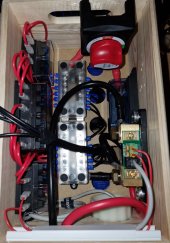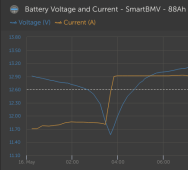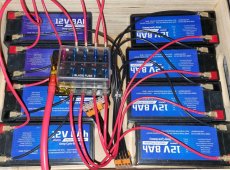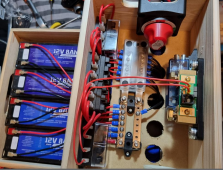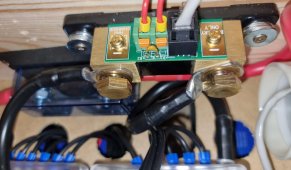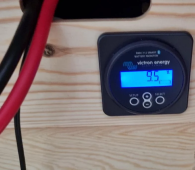Archerite
New Member
I have a self build battery bank with 11 8Ah LiFePO4 batteries which should be a total capacity of 88Ah. Right? I have been using this battery for a little over a month now and besides the small capacity I am really happy with it. It's charged from solar 98% of the time and if it get's to low I use a grid charger but that's really slow at 5A.
Last night I was testing something and forgot to disconnect it in time....and the victron smart shunt showed 0% already! Whoops. But to my bigger surprise the system was still on...at 11.8v so far to low. I don't have a batteryprotect installed yet...going to look into that really soon. But what's even more suprising is the deepest discharge shown by the shunt:

Where did that 7Ah come from??? Is it an error in the shunt's calculations? Last sync was only 4 days ago. I have been using high power 150-200 watts in that time, and some of it got recharged by solar up to 80-90%. Is this something that happens more often that a deep discharge gives more than total rated capacity in a parallel battery system?
This is the battery I am using (11 in parallel): https://www.eco-worthy.com/collecti...4-12v-8ah-24ah-lithium-iron-phosphate-battery
I had expected the BMS inside each battery to be shutoff already but it seems they had more capacity than they are rated for. It was 03:40AM that I noticed it...so no sun keeping the system on either. They are deep cycle batteries so I think this one time going below 0% is not to damaging....at least I hope not.
Last night I was testing something and forgot to disconnect it in time....and the victron smart shunt showed 0% already! Whoops. But to my bigger surprise the system was still on...at 11.8v so far to low. I don't have a batteryprotect installed yet...going to look into that really soon. But what's even more suprising is the deepest discharge shown by the shunt:

Where did that 7Ah come from??? Is it an error in the shunt's calculations? Last sync was only 4 days ago. I have been using high power 150-200 watts in that time, and some of it got recharged by solar up to 80-90%. Is this something that happens more often that a deep discharge gives more than total rated capacity in a parallel battery system?
This is the battery I am using (11 in parallel): https://www.eco-worthy.com/collecti...4-12v-8ah-24ah-lithium-iron-phosphate-battery
I had expected the BMS inside each battery to be shutoff already but it seems they had more capacity than they are rated for. It was 03:40AM that I noticed it...so no sun keeping the system on either. They are deep cycle batteries so I think this one time going below 0% is not to damaging....at least I hope not.



